#actor patricia neal
Explore tagged Tumblr posts
Text


This dress is an example of the same actress wearing the same costume twice. The reuse does seem to be intentional.
Patricia Neal wore this black gown trimmed with white fur in the 1949 film adaptation of Ayn Rand's The Fountainhead. The same year, she wore the dress in It’s a Great Feeling, which takes place in a movie studio. Neal, along with several other actors played themselves in the film, and the reuse of her costume indicates that in the world of It’s a Great Feeling, Neal was filming The Fountainhead.
Costume Credit: Jim Bastas, Solidmoonlight
Follow: Website | Twitter | Facebook | Pinterest | Instagram
357 notes
·
View notes
Text

Patricia Neal and Paul Newman during filming of Martin Ritt’s HUD (1963). Neal won the Best Actress Academy Award for her performance in the film. But, a favorite, she was always truthful and moving on film. Terrific actor.
44 notes
·
View notes
Text

In 1951, Hollywood saw the release of one of its most groundbreaking sci-fi films, "The Day the Earth Stood Still," a movie that would change the way audiences viewed extraterrestrial life, space, and the future of humanity. Directed by Robert Wise, who later directed classics like "West Side Story" and "The Sound of Music," this film stands out as a landmark in science fiction cinema, tackling themes of war, peace, and the unknown. But what went on behind the scenes of this cinematic masterpiece is as fascinating as the film itself, filled with innovation, challenges, and moments that would forever be remembered by those who were a part of it.
The movie's plot revolves around Klaatu, a humanoid alien, and his giant robot companion, Gort, who land on Earth to warn humanity about its violent tendencies and potential for self-destruction. Set against the backdrop of the Cold War and post-World War II anxiety, the storyline served as a cautionary tale about the dangers of nuclear power and the need for peaceful coexistence, resonating with audiences in ways few films of the time could.
Robert Wise was instrumental in bringing "The Day the Earth Stood Still" to life. Known for his meticulous approach, Wise worked tirelessly to ensure that every aspect of the film felt authentic, even when dealing with futuristic concepts and beings from outer space. He collaborated closely with screenwriter Edmund H. North, who adapted the story from Harry Bates' short story "Farewell to the Master." North's script added depth to the characters and highlighted the importance of Klaatu's message of peace, ensuring the story carried a universal appeal that transcended the typical “alien invasion” trope.
A major challenge for the production was casting the role of Klaatu. Wise wanted an actor who could embody the calm, wisdom, and otherworldly presence required for the part, but it wasn’t easy finding the right fit. After several auditions, the role went to British actor Michael Rennie, who was relatively unknown in Hollywood at the time. Wise believed Rennie’s unfamiliar face would help the audience accept him as an alien visitor. Rennie’s portrayal of Klaatu became iconic, with his gentle yet authoritative demeanor capturing the audience’s attention and making Klaatu’s character one of the most memorable in science fiction history.
The film’s visual effects, while basic by today’s standards, were groundbreaking in 1951. The giant robot Gort was brought to life through a combination of a costume and clever camerawork. Lock Martin, a 7'7" actor, was cast to play Gort, but wearing the robot suit was challenging for him due to its weight and limited visibility. Behind the scenes, crew members had to assist Martin in donning the heavy suit and guide him during filming to ensure he didn’t stumble. Martin’s towering presence added an imposing quality to Gort, and the scenes where he interacts with Klaatu and the humans around him were filmed carefully to emphasize his intimidating and mysterious nature.
The special effects team also faced unique challenges with the spaceship Klaatu arrives in. The craft needed to look realistic enough to convince audiences of its extraterrestrial origin. To achieve this, the team used matte paintings, models, and lighting techniques to create the illusion of a seamless, metallic surface. The design and execution of the spaceship were revolutionary, inspiring future sci-fi films to think creatively about how to depict alien technology.
One of the most iconic phrases in sci-fi history, “Klaatu barada nikto,” emerged from this film. Spoken by Helen Benson, the female lead played by Patricia Neal, the phrase serves as a command to Gort to halt his destructive actions. The origins and meaning of this phrase have sparked debate among fans and scholars for decades, but North never clarified its exact translation, leaving it open to interpretation. Neal herself later revealed that she had little idea of the significance of the line while filming, only realizing its impact after the film’s release. Over the years, “Klaatu barada nikto” has become a cultural touchstone, referenced in numerous films, TV shows, and even video games, symbolizing the mysterious nature of alien communication.
Behind the scenes, Patricia Neal’s experience on set was both exciting and challenging. Although her role required her to interact with an alien and a giant robot, Neal approached her character with dedication, bringing depth and realism to her performance. She later admitted that some scenes, particularly those involving Gort, were daunting because of the suit’s intimidating presence. Her chemistry with Michael Rennie helped create believable interactions, and her character’s bravery and intelligence left a lasting impression on audiences.
The score, composed by Bernard Herrmann, was another critical element that set "The Day the Earth Stood Still" apart from other sci-fi films of the time. Herrmann used a theremin, an unusual electronic instrument, to create eerie, otherworldly sounds that became synonymous with science fiction. The theremin’s distinctive sound added to the film’s atmosphere, giving it a haunting quality that underscored Klaatu’s message and the film’s tension-filled moments. Herrmann’s music elevated the film, influencing how future sci-fi soundtracks would be composed.
2 notes
·
View notes
Text
choosing my noirvember for tonight like which character actor do i wanna spend ninety minutes with tonight, wendell corey or patricia neal or dan duryea
7 notes
·
View notes
Text
The Fountainhead , 1949

The Fountainhead is a 1949 American black-and-white drama film produced by Henry Blanke, directed by King Vidor, and starring Gary Cooper, Patricia Neal, Raymond Massey. The script was written by Ayn Rand.
Roark is a brilliant architect. However, he always has to go his own way, even if it means damaging his career. At the start of the film, we watch Howard Roark losing one opportunity after another. Also, he takes menial work as a quarryman to finance his projects. He falls in love with heiress Dominique (Patricia Neal), but ends the relationship when he has the opportunity to construct buildings according to his own wishes. Dominique marries a newspaper tycoon (Raymond Massey) who at first conducts a vitriolic campaign against the radical Roark, but eventually becomes his strongest supporter.
The stormy and subversive character of Roark dynamizes the script which contains, in addition to love with Dominique, a trial, a suicide and a debate between two opposite philosophies: individualism vs. collectivism.
The reviews for this movie are divided, some people liked it a lot and some didn't like it at all. What is your opinion ?
Relative posts :
7 notes
·
View notes
Text
list of classic movie actors I don't like
Kirk Douglas
Loretta Young
Robert Cummings
Tony Curtis
Jack Lemmon
Robert Wagner
Burt Lancaster
Robert Walker
Robert Taylor
Jennifer Jones
Greta Garbo
Norma Shearer
Alan Ladd
Veronica Lake
Patricia Neal
Jane Wyman
Carole Landis
Rex Harrison
Capucine
June Allyson
Stewart Granger
sterling Hayden
Franchot tone
0 notes
Text
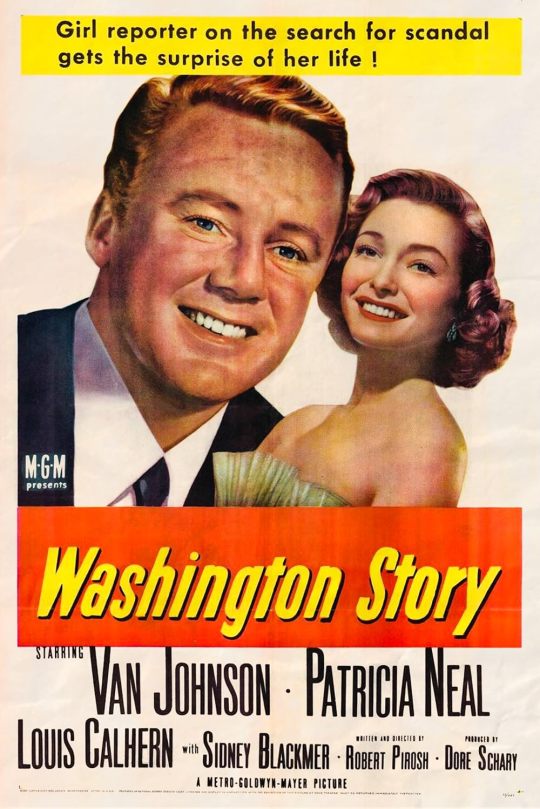
100+ Films of 1952
Film number 104: Washington Story
Release date: July 1st, 1952
Studio: MGM
Genre: drama
Director: Robert Pirosh
Producer: Dore Schary
Actors: Patricia Neal, Van Johnson, Louis Calhern
Plot Summary: Alice is a “girl reporter” who comes to Washington D.C. looking for a story about political corruption. She begins following Rep. Gresham, a young politician from Massachusetts, covering his day-to-day activities. But is his idealistic image real? Is his vote on an upcoming bill being bought?
My Rating (out of five stars): ***
This is another “meh” film from MGM. It’s not especially good, but it’s not especially bad either. The main problem is that the poster claiming Alice will get the “surprise of her life” is a ridiculous oversell. There was some mystery about what characters were or were not corrupt, but it didn’t last long, and the stakes were disappointingly low. (Some spoilers)
The Good:
Patricia Neal! Patricia Neal! A major reason I wanted to see this film was because she was in it. She’s got class and swagger in equal amounts, she’s beautiful in a unique way, and her voice is like mother’s milk to me. Her charisma carries the film.
Van Johnson. I wasn’t sure if he’d be believable as a politician, but it worked for the most part. He had the air of a young, dashing, East Coast Representative- a bit like a more mild-mannered Kennedy. He still seems like way too nice of a guy to be in Congress, though!
Louis Calhern as Rep. Birch. He’s always delightful as a character actor, and he was a highlight here. He was the one character whose morality I actually questioned.
The amazing access to the Capitol building. Some of the movie used sets, but a lot of it was shot in and around the actual building. It was especially cool to see the “subway” trolley thing that members of Congress used to get around at that time.
The minutia of daily lives for Representatives was shown in a low-key realistic way. We see committee meetings, the floor of congress, Gresham practicing for a TV speech, talking to lobbyists and constituents in his office in the building, etc.
“Ward Cleaver” as a House chaplain! It was a “blink and you’ll miss him” moment but fun anyway. I think it was an MGM movie earlier in the year where Barbara Billingsley (June Cleaver) had a role of similar length!
A fun moment when Gresham meets a group of Boy Scouts and some are holding a sign that says, “We’ll vote for you in 1962!”
The wrap around device of a Capitol building tour guide.
The Bad:
Van Johnson as a possible villain. Here’s a case where a lesser-known actor might have been better for the role. I only questioned for about 10 seconds if Johnson could be a “baddie” or not. Would MGM ever make Johnson a villain? Never! It’s not Johnson’s fault as an actor, it’s just that he was MGM’s golden boy, and I knew they’d never allow him to be corrupt.
The lack of any real thrills or suspense. The big bill coming up for a vote in the film is about... ship building dispersal?? I mean... really? It’s not exactly something that grips an audience.
It starts off seeming like a grittier version of Mr. Smith Goes to Washington but ends up much more sanitized than Capra. I adore Mr. Smith Goes to Washington, but it does have a dose of Capra sentimentality. However, it is actually a much more dark and cynical film than this one. In Mr. Smith, Washington D.C. is a place filled with corruption and smashed ideals. In Washington Story, all the politicians are good guys. It’s a lobbyist and a muckraking reporter who suck. This didn’t exactly feel realistic! Mr. Smith was a film that ripped your heart out- this movie was a mild diversion by comparison.
The fact that a reporter writing a story about a Representative hooks up romantically with said Representative after only a couple of days! This was highly questionable, especially because the film made no issue of it, as if it was a perfectly normal acceptable thing.
I don’t know if Johnson and Neal had much chemistry together. Their basic character traits didn’t quite jibe- Neal always comes across as bitingly intelligent, sophisticated, and worldly-wise. Johnson is the sweet boy next door “aw shucks” type.
The style of the whole film was kind of flat. Nothing about the visuals or sound stood out at all for me.
Some truly bad rear projection in a scene where Neal and another journalist ride the subway inside the Capitol. Apparently, the projected stuff in the background was from the real location, but it zipped past its stopping point twice!
#1952#1952 movies#100 films of 1952#patricia neal#van johnson#200 films of 1952 film 104#200 films of 1952
0 notes
Text

BURGESS MEREDITH ⭐
A 116 años de su nacimiento.
16 de noviembre de 1907.
Oliver Burgess Meredith nace en Cleveland, Ohio, Estados Unidos; un 16 de noviembre de 1907, y fallece en Malibú, California, Estados Unidos; un 9 de septiembre de 1997, fue un famoso actor estadounidense, candidato al Óscar en dos ocasiones.
Actuó en más de 100 películas, así como en diferentes series de televisión, siendo reconocido también por poner la voz al personaje animado "Puff, el dragón mágico".
Apareció más de 170 veces en televisión.
Interpretó al villano El Pingüino en la serie de televisión Batman en los años 1960 y también en el filme derivado de ella, Batman (1966).
Otro de sus personajes más recordados es el entrenador de Rocky Balboa, Mickey Goldmill, en la saga de cine Rocky, protagonizada por Sylvester Stallone.
También participó en la primera versión de Furia de titanes (1981), con estrellas como Laurence Olivier y Ursula Andress, y en Dos viejos gruñones, junto a Jack Lemmon y Walter Matthau.
Incluso tuvo un contacto con el cine español: rodó con José Luis Borau Hay que matar a B. (1974), junto a un reparto internacional que incluía a Patricia Neal.
1 note
·
View note
Photo

All battles are fought by scared men who'd rather be someplace else. Jerry Goldsmith - In Harm's Way - Original Soundtrack (1965) Don't skip - Liz In Harm's Way Underrated track - Change Of Command So this is honestly a GRAIL for me. In Harm's Way is my all time favorite movie...I know, weird, but hear me out. I love war movies, and this one just caught my eye at a young age, maybe 5 or so, on a Sunday afternoon TV matinee when I was home sick. I just fell in love with it. And honestly is just a killer cast too...John Wayne, Henry Fonda, Kurt Douglas, Patricia Neal, Burgess Merideth and young actors Larry Hagman and Carroll O'Connor. But even beyond that, I remember being young and just in awe of how the music seemed to make the movie move along. As with all Otto Preminger movies, music wasn't for the background. He used the music along with long sections of action without dialog to set the tone. And I just love the music to this movie...but have never seen it on vinyl until now. Thanks to @dalesrecordsandskateshop for being awesome and having this great copy in a bargain bin. It's one of those albums that the sentimental will always outweigh the actual monetary value. But anyways...you should watch the movie and listen to this soundtrack...you won't be sorry! #soundtrack #inharmsway #fattyvinylsession #discogs #vinyl #vinygram #vinylcommunity #audiotechnica #recordoftheday #recordcollector #vinyljunkie #nowplaying #nowspinning #igvinyl #vinyladdict #instavinyl #onmyturntable #vinyllove (at Chateau Ruff N Baker City Deux) https://www.instagram.com/p/CqYN-3LOn3_/?igshid=NGJjMDIxMWI=
#soundtrack#inharmsway#fattyvinylsession#discogs#vinyl#vinygram#vinylcommunity#audiotechnica#recordoftheday#recordcollector#vinyljunkie#nowplaying#nowspinning#igvinyl#vinyladdict#instavinyl#onmyturntable#vinyllove
0 notes
Photo

Winner of 3 Oscars: Patricia Neal, Best Actress, Melvyn Douglas, Best Supporting actor, James Wong Howe's 2nd win for cinematography. HUD (1963), tonight at 8:00 PM on #TCM. #31DaysOfOscar #OscarWinner #Western #OscarHistory https://www.instagram.com/p/Cp7o5vegc9m/?igshid=NGJjMDIxMWI=
0 notes
Photo

The Day the Earth Stood Still (1951)
#1950s#actor patricia neal#dir robert wise#dp leo tover#cat sci fi#american#monochrome#shadow#collar#teeth#earrings#lipstick#halo#the day the earth stood still 1951
15 notes
·
View notes
Text

So fucki@$$ love her ❤️❤️❤️
#actors#keeley hawes#bodyguard#julia montague#ashes to ashes#lavender#the durrells#netflix#louisa durrell#keeley#an unquiet life#patricia neal#summer of rockets#kathleen shaw#alex drake#film#the durrells in corfu#tv actress#british actress
39 notes
·
View notes
Text
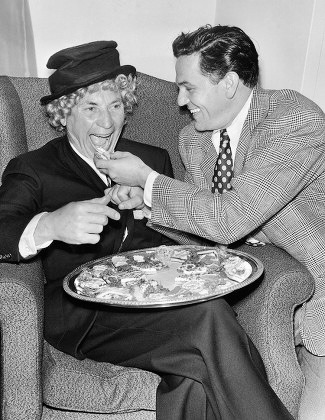
JULIE DOING “STUFF” WITH FAMOUS PEOPLE (10th post)
Above Julie takes finger food to a new level with Harpo Marx.

Above with Patricia Neal in a still from THE BREAKING POINT.

Julie and Jennifer Jones mask up as they dig a freedom fighting tunnel WE WERE STRANGERS.
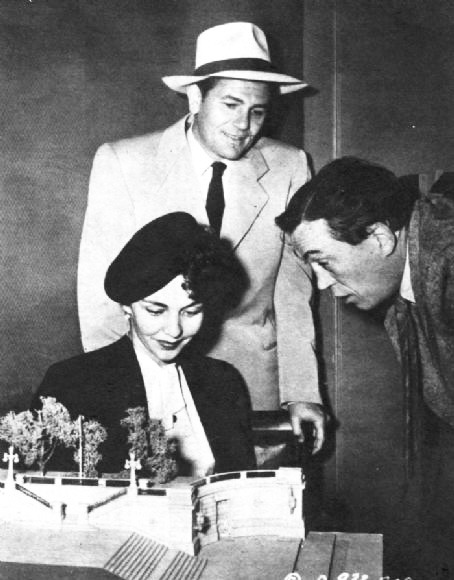
The two actors are getting some background behind the scenes from director, John Huston for the same film.
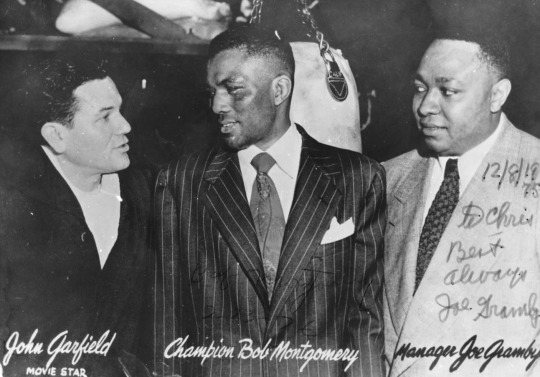
Wonder if Julie picked up some tips from boxer, Bob Montgomery for BODY AND SOUL? Montgomery was a boxer who took the New York State Athletic Commission World Lightweight Championship in May 1943, and again in March 1944. His managers included Joe Gramby.

Pictured above in one of the earliest USO Tours, The Flying Showboat in 1941.

The Flying Showboat with John Garfield, Ray Bolger, Mitzi Mayfair, Oliver Hardy, Jane Pickens, Stan Laurel and Chico Marx in Miami on November 1, 1941. Here’s some explanation about The Flying Showboat from Laurel & Hardy Central:
“The Flying Showboat, a revue toured U.S. military bases in the Caribbean. Once again, Chico Marx was on board, with other stars such as singer Jane Pickens, dancer Ray Bolger and actor John Garfield, who acted as master of ceremonies. These stars performed under some extremely trying conditions, as the weather was brutally hot and many of the camps were not equipped to host theatrical performances. Chico, whose "shoot the keys" piano solos were the heart of his act, often had to do without a piano at all. Thankfully, Laurel and Hardy's Driver's License sketch needed only a few simple props. In any event, even the most ramshackle shows brought loud cheers from the troops, overjoyed that anybody had come to perform for them, let alone some of the finest talents Hollywood had to offer.”
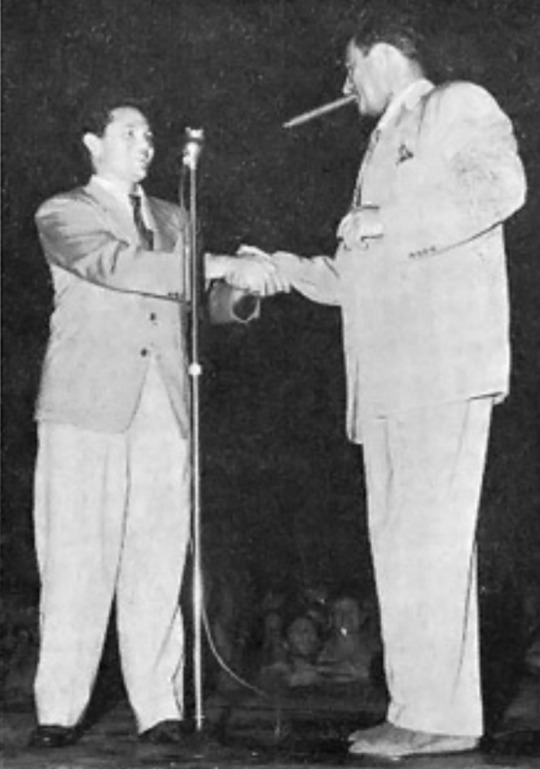
Julie performs with actor, George Tobias at another USO show at Drew Field during the making of AIR FORCE.
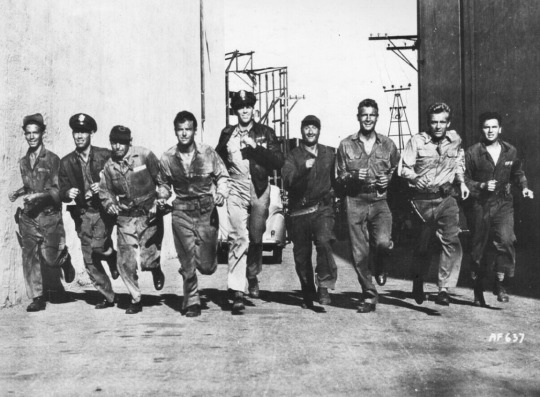
The ensemble is ready for action for the film AIR FORCE directed by Howard Hawks.
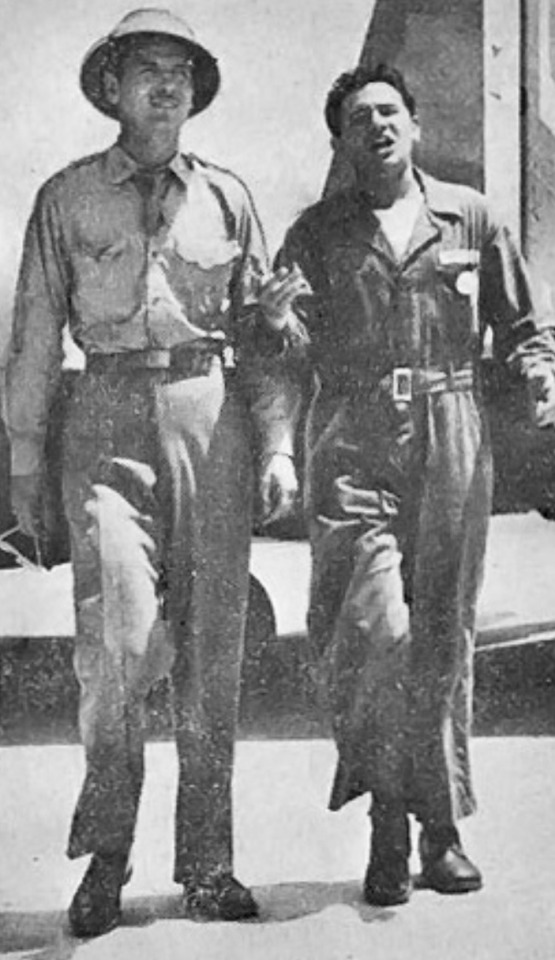
Julie is pictured above with actor, Gig Young at Drew Field on location for AIR FORCE.
#john garfield#harpo marx#laurel and hardy#jennifer jones#ray bolger#Chico Marx#John Houston#we were strangers#the breaking point#Patricia Neal#air force film#howard hawks#gig young#george tobias#the flying Showboat#Julie doing “stuff” with famous people
22 notes
·
View notes
Text
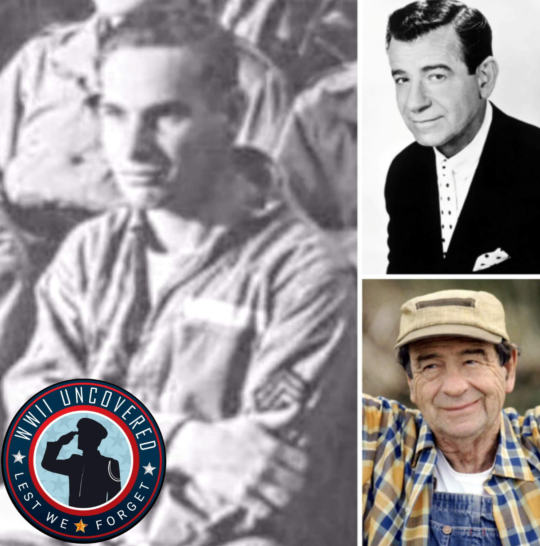
Walter Matthau: Veteran of the Battle of the Bulge
Born Walter John Matuschanskayasky on October 1, 1920 in the Lower East Side of Manhattan New York City - Walter Matthau enlisted with the US Army Air Forces after graduating from Seward Park High School in Manhattan, New York City.
According to the Together We Served Database: "Walter served with the Eighth Air Force in England as a B-24 Liberator radioman-gunner, in the 453rd Bombardment Group. While based in England at RAF Old Buckenham in Norfolk, he flew missions across continental Europe including aerial combat during the Battle of the Bulge. Staff Sergeant Walter Matthau served from 1942 through 1945 and was decorated with the Air Medal in addition to numerous other honours including six Battle Stars.
After the war Walter proceeded to study acting in New York - he took some journalism courses at Columbia University and used his G.I. benefits to study at the New School's Dramatic Workshop under the director, Erwin Piscator.
According to the IMDb Database: "Matthau appeared in the pilot of Mister Peepers (1952) alongside Wally Cox. He later appeared in the Elia Kazan classic, A Face in the Crowd, opposite Patricia Neal and Andy Griffith, and then appeared in Lonely Are the Brave (1962), with Kirk Douglas, a film Douglas has often described as his personal favorite. Matthau then appeared in Charade (1963) with Audrey Hepburn and Cary Grant.
In addition to the aforementioned, Walter performed on Broadway in such classics as Hello, Dolly! and his breakthrough role as Oscar Madison, the disheveled sportswriter in Neil Simon's 1965 Broadway comedy and 1968 film ''The Odd Couple.'' In 1968, Matthau made his big screen appearance as Oscar Madison in The Odd Couple alongside Jack Lemmon. The two were also in the sequel, The Odd Couple II (1998) as well as Grumpy Old Men (1993) and Grumpier Old Men (1995). With a career that spanned over 50 years Walter was honored with an Academy Award, BAFTA Award, Tony Award and a Golden Globe Award.
Neil Simon praised Matthau as "the greatest instinctive actor" he'd ever seen.
Staff Sergeant Walter Matthau passed away on July 1, 2000 at the age of 79. He lies in rest at Westwood Village Memorial Park Cemetery in Los Angeles California. Lest We Forget.
WW II uncovered
Walter Matthau
27 notes
·
View notes
Text
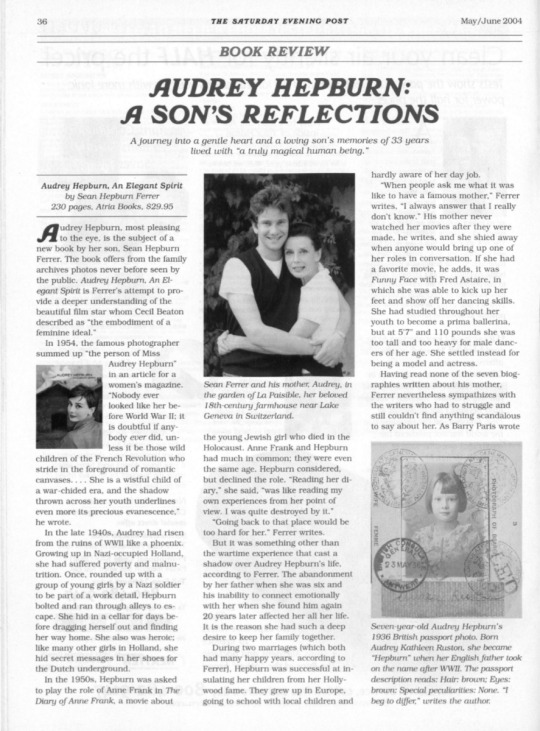
The Saturday Evening Post Book Review May/June 2004
AUDREY HEPBURN: A SON’S REFLECTIONS
A journey into a gentle heart and a loving son’s memories of 33 years lived with “a truly magical human being.”
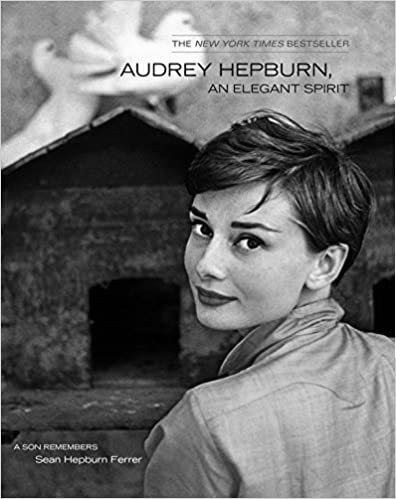
Audrey Hepburn, An Elegant Spirit by Sean Hepburn Ferrer 230 pages, Atria Books, $29.95
Audrey Hepburn, most pleasing to the eye, is the subject of a new book by her son, Sean Hepburn Ferrer. The book offers from the family archives photos never before seen by the public. Audrey Hepburn, An Elegant Spirit is Ferrer’s attempt to provide a deeper understanding of the beautiful film star whom Cecil Beaton described as “the embodiment of a feminine ideal.”
In 1954, the famous photographer summed up “the person of Miss Audrey Hepburn” in an article for a women’s magazine. “Nobody ever looked like her before World War II; it is doubtful if anybody ever did, unless it be those wild children of the French Revolution who stride in the foreground of romantic canvases. . . . She is a wistful child of a war-chided era, and the shadow thrown across her youth underlines even more its precious evanescence,” he wrote.
In the late 1940s, Audrey had risen from the ruins of WWII like a phoenix. Growing up in Nazi-occupied Holland, she had suffered poverty and malnutrition. Once, rounded up with a group of young girls by a Nazi soldier to be part of a work detail, Hepburn bolted and ran through the alleys to escape. She hid in a cellar for days before dragging herself out of finding her way home. She was also heroic; like many other girls in Holland, she hid secret messages in her shoes for the Dutch underground.

Sean Ferrer and his mother, Audrey, in the garden of La Paisible, her beloved 18th-century farmhouse near Lake Geneva in Switzerland.
In the 1950s, Hepburn was asked to play the role of Anne Frank in The Diary of Anne Frank, a movie about the young Jewish girl who died in the Holocaust. Anne Frank and Hepburn had much in common; they were even the same age. Hepburn considered, but declined the role. “Reading her diary,” she said, “was like reading my own experiences from her point of view. I was quite destroyed by it.”
“Going back to that place would be too hard for her.” Ferrer writers.
But it was something other than the wartime experience that cast a shadow over Audrey Hepburn’s life, according to Ferrer. The abandonment by her father when she was six and his inability to connect emotionally with her when she found him again 20 years later affected her all her life. It is the reason she had such a deep desire to keep her family together.
During two marriages (which both had many happy years, according to Ferrer), Hepburn was successful at insulating her children from her Hollywood fame. They grew up in Europe, going to school with local children and hardly aware of her day job.
“When people ask me what it was like to have a famous mother,” Ferrer writes, “I always answer that I really don’t know.” His mother never watched her movies after they were made, he writes, and she shied away when anyone would bring up one of her roles in conversation. If she had a favorite movie, he adds, it was Funny Face with Fred Astaire, in which she was able to kick up her feet and show off her dancing skills. She had studied throughout her youth to become a prima ballerina, but at 5’7” and 110 pounds she was too tall and too heavy for male dancers of her age. She settled instead for being a model and actress.
Having read none of the seven biographies written about his mother, Ferrer nevertheless sympathizes with the writers who had to struggle and still couldn’t find anything scandalous to say about her. As Barry Paris wrote, in a recent book about Hepburn, “The worst thing she ever did, it seems, was forget to mention Patricia Neal at the 1964 Oscars” when she subbed for the ailing Neal in presenting the award for Best Actor.
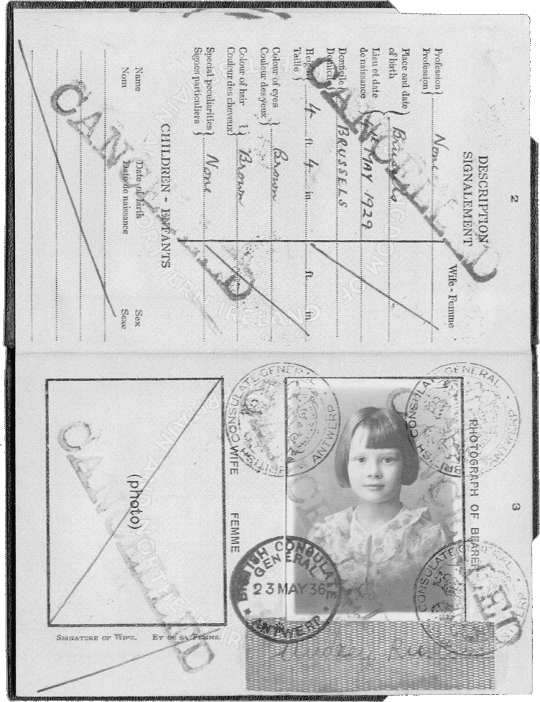
Seven-year-old Audrey Hepburn’s 1936 British passport photo. Born Audrey Kathleen Ruston, she became “Hepburn” when her English father took on the name after WWII. The passport description reads: Hair: brown; Eyes: brown; Special peculiarities: None. “I beg to differ,” writes the author.
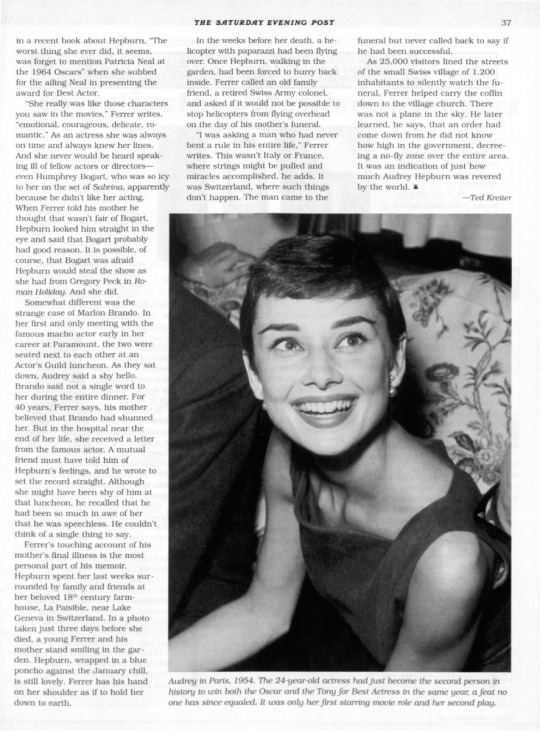
“She really was like those characters you saw in the movies,” Ferrer writes, “emotional, courageous, delicate, romantic.” As an actress she was always on time and always knew her lines. And she never would be heard speaking ill of fellow actors or directors—even Humphrey Bogart, who was so icy to her on the set of Sabrina, apparently because he didn’t like her acting. When Ferrer told his mother he thought that wasn’t fair of Bogart, Hepburn looked him straight in the eye and said that Bogart probably had good reason. It is possible, of course, that Bogart was afraid Hepburn would steal the show as she had from Gregory Peck in Roman Holiday. And she did.
Somewhat different was the strange case of Marlon Brando. In her first and only meeting with the famous macho actor early in her career at Paramount, the two were seated next to each other at an Actor’s Guild luncheon. As they sat down, Audrey said a shy hello. Brando said not a single word to her during the entire dinner. For 40 years, Ferrer says, his mother believed that Brando had shunned her. But in the hospital near the end of her life, she received a letter from the famous actor. A mutual friend must have told him of Hepburn’s feelings, and he wrote to set the record straight. Although she might have been shy of him at the luncheon, he recalled that he had been so much in awe of her that he was speechless. He couldn’t think of a single thing to say.
Ferrer’s touching account of his mother’s final illness is the most personal part of his memoir. Hepburn spent her last weeks surrounded by family and friends at her beloved 18th century farmhouse, La Paisible, near Lake Geneva in Switzerland. In a photo taken just three days before she died, a young Ferrer and his mother stand smiling in the garden. Hepburn, wrapped in a blue poncho against the January chill, is still lovely. Ferrer has his hand on her shoulder as if to hold her down to earth.
In the weeks before her death, a helicopter with paparazzi had been flying over. Once Hepburn, walking in the garden, had been forced to hurry back inside. Ferrer called an old family friend, a retired Swiss Army colonel, and asked if it would not be possible to stop helicopters from flying overhead on the day of his mother’s funeral.
“I was asking a man who had never bent a rule in his entire life,” Ferrer writes. This wasn’t Italy or France, where strings might be pulled and miracles accomplished, he adds. It was Switzerland, where such things don’t happen. The man came to the funeral but never called back to say if he had been successful.
As 25,000 visitors lined the streets of the small Swiss village of 1,200 inhabitants to silently watch the funeral, Ferrer helped carry the coffin down to the village church. There was not a plane in the sky. He later learned, he says, that an order had come down from he did not know how high in the government, decreeing a no-fly zone over the entire area. It was an indication just how much Audrey Hepburn was revered by the world. —Ted Kreiter
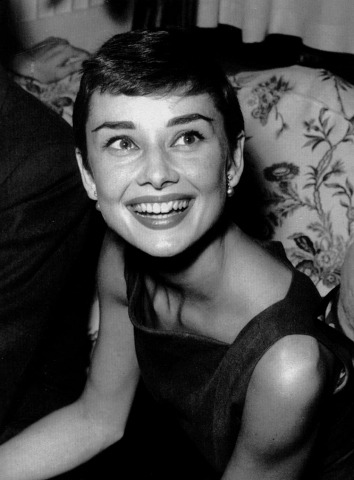
Audrey in Paris, 1954. The 24-year-old actress had just become the second person in history to win both the Oscar and the Tony for Best Actress in the same year, a feat no one has since equaled. It was only her first starring movie role and her second play.
7 notes
·
View notes
Photo

NOIR CITY Hollywood closes tonight with NO WAY OUT (7:00) and THE BREAKING POINT (9:30) at the Hollywood Legion Theater. Films introduced by Eddie Muller and Alan K. Rode. Tickets available at https://bit.ly/3tLWDSn NO WAY OUT (1950)-7:00PM
Runtime: 106 min. Format: DCP 20th Century Fox (Disney)
Directed by: Joseph L. Mankiewicz
The late Sidney Poitier made his screen debut as Dr. Luther Brooks, who treats a pair of low-life criminal brothers wounded while trying to rob a gas station. Ray Biddle, a virulent racist (Richard Widmark at his most incendiary) refuses to be treated by a black man and, when his brother dies, he accuses Dr. Brooks of murder. The incident touches off a firestorm that threatens to erupt in an all-out race war. In the middle is Johnny’s ex-wife Edie (Linda Darnell) stuck between the ingrained racism of her neighborhood and a growing awareness of the world beyond its confines. Widmark and Poitier give riveting performances, and Darnell quietly steals the show as a woman seeking to escape the ignorance of her upbringing. Joe Mankiewicz’s Oscar® nominated screenplay pulls no punches in its squirm-inducing depiction of deeply rooted racism. A powerful film that is, sadly, as relevant today as it was over seventy years ago.
Introduction by Eddie Muller

THE BREAKING POINT (1950)-9:30PM
Runtime: 97 min. Format: 35mm Warner Bros. Directed by: Michael Curtiz
The finest film version of Hemingway’s novel To Have and Have Not (and yes, that includes the Bogart-Bacall classic) shifts the locale from Cuba to Newport Beach but retains the novel’s core of noir-stained tragedy. In his second to last film, John Garfield essays his finest screen portrayal as skipper Harry Morgan, whose financial hardship and domestic travails result in crime, flight and death. Garfield’s turn is perfectly matched by a saucy Patricia Neal (on the make for Garfield) and Phyllis Thaxter as his worn-out but unswervingly loving wife. With Wallace Ford as the ultimate bottom-feeding shyster and the great Afro-Puerto Rican actor Juano Hernandez in a non-stereotypical sidekick role. Michael Curtiz’s best post-WWII film includes a climactic finale that would make a stone weep. With: Edmon Ryan, Guy Thomajan, William Campbell and Sherry Jackson.
Introduction by Alan K. Rode
35mm print funded by the Film Noir Foundation and courtesy of UCLA Film & Television Archive
16 notes
·
View notes